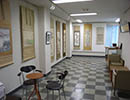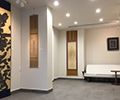SEARCH
» home» Art glossary
Art glossary
yamatoe
Yamatoe is a style of the depiction that had been cultivated under the Japanese indigenous natural features and customs.
nanga ( Bunjinga )
Nanga ( bunjinga ) was a school of Japanese painting in the late edo period, had been influenced by Chinese literati painting. Nanga ( bunjinga ) painter almost always depicted Chinese subjects such as landscapes, birds, flowers and other, with having admiration for traditional Chinese culture.
Tosa school
Tosa school is a school of Japanese painting "Yamatoe", was founded in Heian period ( 15th century ).
shigasan
Painting with Chinese poem, a traditional style of Oriental painting
tomobako
Original box, usually made of paulownia wood, that holds a hanging scroll. On the lid are the title of work and signature inscribed by the artist.
awasebako
Box, usually made of paulownia, that holds a hanging scroll. The lid is not inscribed with the title of work or signature by the artist.
nijubako
Outer box that holds an inner box containing a hanging scroll. In most cases a lacquered paulownia box.
hyogu(hyoso)
To mount a work of art onto a hanging scroll or byobu screen using traditional techniques and materials (mainly silk fabric, washi paper, and starch paste). “Hyougu” sometimes refers to the decorative surface around the work.
kinrandonsu
Silk fabric or brocade with gold foil woven into it
kouhon
Burnished silk fabric, made from raw silk.
Ivory tips
Hanging scrolls with ivory tips can't clear customs or export. The ivory tips will be replaced with tips of other materials for overseas trade.
condition index
kou / Ever good
otsu / Good
hei / Slightly damaged but adequate artistic merit
tei / Damaged but adequate artistic merit

